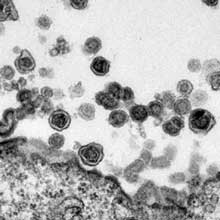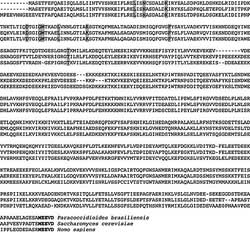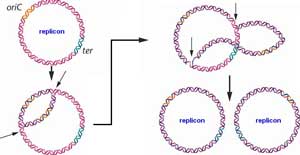 WPI Response – Dr. Mikovits reponse to the request for retraction started off with a blast -at none other than the editor in chief of the most influential science journal in the world over what appeared to be a relatively minor issue – a day or so breach in a papers embargo – which she called “gross disregard for the integrity of the scientific process”
WPI Response – Dr. Mikovits reponse to the request for retraction started off with a blast -at none other than the editor in chief of the most influential science journal in the world over what appeared to be a relatively minor issue – a day or so breach in a papers embargo – which she called “gross disregard for the integrity of the scientific process” Dr .Mikovits, on the other hand, appeared to have good reasons to be upset. In a Science Now article she noted that the request for retraction came on a Thursday afternoon before a holiday weekend leaving her and the others “pretty well stunned,” . The WPI knew that two more negative papers were coming out – virtually every body knew that – but with Science set to publish in 6 days, and without the new papers in hand, she clearly felt squeezed. It didn’t help that the news leaked a day early – causing the publication process to move up.
The big issue, though, was the Journals request for the Lombardi et al authors to retract the paper and its decision to append a “Expression of Concern’ stating that the results of the Lombardi et al study were most likely due to contamination. The Editor in Chief of Science, Dr. Bruce Alberts, stated “the results are now seriously in doubt”.
Dr. Mikovits stated that all the original authors, except for one, refused to retract the paper. In a Bloomberg news article https://www.bloomberg.com/news/2011-0…forumid=331851 Dr. Lipkin, the lead researcher in one of the NIH studies, stated that he felt that calls for a retraction were premature. Both NIH studies will continue with a due date by the end of the year.
 Chilling Effect – Requesting the retraction and adding the “Expression of Concern” to the study was a serious matter that will have a chilling effect on the field but how chilling isn’t clear…as the research community is well aware of the issues surrounding XMRV. Dr. Mikovits, though, asserted that the Expression of Concern would have ‘a disastrous effect on the future of this field”. Annette Whittemore, President of the WPI, stated “We are extremely disappointed that the editor of Science has published an ‘editorial expression of concern,’”
Chilling Effect – Requesting the retraction and adding the “Expression of Concern” to the study was a serious matter that will have a chilling effect on the field but how chilling isn’t clear…as the research community is well aware of the issues surrounding XMRV. Dr. Mikovits, though, asserted that the Expression of Concern would have ‘a disastrous effect on the future of this field”. Annette Whittemore, President of the WPI, stated “We are extremely disappointed that the editor of Science has published an ‘editorial expression of concern,’”
Science could have simply retracted the article themselves but chose not to do so – putting themselves in something of logical impasse by asking the authors to retract the study but refusing to do that themselves. Instead the Science journal will wait, as others are, for the results of the all important NIH studies before they take any more steps.
Major Response – It was not surprising, to see Dr. Mikovits produce her fullest response yet. In a long letter to Science she went over the original studies numerous accomplishments , suggested that many gammaretroviruses may very well have emanated from human tissue/mouse tissue culture experiments and then attempted to cast doubt on whether the studies suggesting contamination is present applied to the WPI.
Dr. Mikovits pointed out the many ways she checked for contamination in the human cell lines, reagents and by using mtDNA. She accepted that contamination in other labs studies but can find no reason to assume that i occurred in her lab or the other labs in the study. Indeed, while negative evidence mounts, there is still no smoking gun…no direct path to contamination at the WPI.
A Storm of Factors – There is no one issue that is turning members of the research against XMRV; instead it’s more of a series of factors that, put together, render XMRV in their minds a very unlikely candidate for disease. The new studies added more to the anti-XMRV argument but they were not definitive’. The new Paprotka paper was not new in the sense that that his data had already been reported in a Conference. The Levy study, not an exact replication study at all, added three things to mix; another well respected researcher came up negative using a variety of techniques, his reagent findings cast doubt on the Lo/Alter paper and his immune tests suggest that XMRV is quickly rendered inert by the immune system – making it difficult to see how it could cause disease.
 The Levy/Knox Study – With over 500 citations to his name, Dr. Levy may be the most prolific researcher yet to put his name on an XMRV study. A co-discoverer of HIV with a long history of gamma retroviral research he is well respected in the field. Lead author Dr. Konstance Knox has participated in several CFS pathogen studies. With researchers from Abbott Labs and the Blood Safety Research Institute (BSRI) also contributing the paper was top-heavy with experience.
The Levy/Knox Study – With over 500 citations to his name, Dr. Levy may be the most prolific researcher yet to put his name on an XMRV study. A co-discoverer of HIV with a long history of gamma retroviral research he is well respected in the field. Lead author Dr. Konstance Knox has participated in several CFS pathogen studies. With researchers from Abbott Labs and the Blood Safety Research Institute (BSRI) also contributing the paper was top-heavy with experience.
56 participants in the study had tested positive for XMRV at the WPI. 19 of had blood drawn for the Levy study and the VIP Dx on the same day. Levy reported that he used the same methodologies reported in the Lombardi et al paper to look for antibodies and nucleic acids and as well as RT-PCR, culture (1-3 weeks) and chemoluminescence assays to look for antibodies. He also assayed XMRV’s ability to withstand attack from the immune system. Finally he assessed contamination in the reagents used in the Lo/Alter study and examined some of the original strains of XMRV.
He was unable to find XMRV in any samples, found contamination in several of the reagents Lo/Alter used and in a twist showed that the complement part of the immune system was able to inactivate XMRV rendering it harmless suggesting that even if the virus was present in the human body that it would be able to do little. (Check out an excellent examination of this study at the CAA’s site here https://www.research1st.com/2011/06/0…-tribulations/
The Propotka study showed how much hinges on XMRV’s genetic variability. That study concluded there was only a 1 in a trillion chance that the strain of XMRV found in the prostate cancer and WPI samples was not accidentally created in a lab some 20 years ago. The possibility that the WPI strains were inadvertently created in a lab is not a problem as labs can and have produced viral strains. The problem is that the strains from the WPI don’t bear any tell-tale remarks suggesting that they have been anywhere else than a lab. Viruses invariably change when they infect humans but the WPI (and prostate cancer) strains are almost exact duplicates of the original lab strains.
 WPI’s Submissions to GenBank Fall Short – Given that its been critical for the WPI to establish that their unpublished isolates display more variability. For over a year they have asserted that and used it as a basis for their claim that VP62 is not a suitable clone to use in research studies. (The last page of the supplemental science paper VP62 (S3) includes a photo showing that VP62 was used in one section of their original paper.)
WPI’s Submissions to GenBank Fall Short – Given that its been critical for the WPI to establish that their unpublished isolates display more variability. For over a year they have asserted that and used it as a basis for their claim that VP62 is not a suitable clone to use in research studies. (The last page of the supplemental science paper VP62 (S3) includes a photo showing that VP62 was used in one section of their original paper.)
The CAA reported that Knox et al’s detailed examination of three sequences from the WPI lead them to conclude that they were similar to the laboratory strain (22RV1) under question. The paper, in fact, stated they were remarkably similar… “Therefore, the remarkable conservation of the WPI-XMRV sequences is most consistent with laboratory contamination with the original infectious VP62.” The CFIDS Association also reported, that a examination of the 18 sequences the WPI supplied to GenBank (which are freely available) indicates that they, too, are virtually identical to the past sequences.
 NCI Analysis of Original XMRV Samples Indicated They Were Likely Contaminants – On their website the NCI reported they have cultivated XMRV from the original samples and upon testing them concluded they too are so genetically similar to the lab strain that they, too, are probably laboratory contaminants.
NCI Analysis of Original XMRV Samples Indicated They Were Likely Contaminants – On their website the NCI reported they have cultivated XMRV from the original samples and upon testing them concluded they too are so genetically similar to the lab strain that they, too, are probably laboratory contaminants.
In a rather devastating but small study that does not appear to have been published yet the NCI also showed they could find XMRV in patient samples from the WPI and then went back and retested the same patients (without having their blood go through the WPI) and were unable to find any XMRV. This, of course, suggests that the patient samples picked up XMRV (were contaminated) as they passed through the WPI – the same conclusion the Shin/Singh study reached.
The Science Journal’s reaction, then, reflected a series of factors. Dr. Coffin, once a avid supporter of XMRV stated “Taken together, these results close the door on XMRV as a cause of human disease.” These researchers clearly believe that the weight of the evidence obviates the need to find a ‘smoking gun’; ie discover the source of contamination at the WPI. (The WPI does not appear to have asked outside researchers to examine its operations).
 Complete Replication – The contamination argument is an important one but it is indirect. The main issue for XMRV may still be the inability of several dozen labs now, including some top labs in the US, to find XMRV in their blood samples. Many reasons for that have been asserted in the past but only one is left now-the lack of precise and complete replication – on the original study. In her response Dr. Mikovits stated:
Complete Replication – The contamination argument is an important one but it is indirect. The main issue for XMRV may still be the inability of several dozen labs now, including some top labs in the US, to find XMRV in their blood samples. Many reasons for that have been asserted in the past but only one is left now-the lack of precise and complete replication – on the original study. In her response Dr. Mikovits stated:
This would suggest that the methods and materials used in the non-replication studies are insufficient to use when attempting to detect human gammaretrovirus in the blood of human samples. The methods, processes, and materials of Lombardi et al. need to be followed precisely. The Alter and Lo study is the only study which has attempted a partial replication of the methods and materials of the Lombardi study, which confirmed evidence of MLV related viruses”
Dr. Mikovits statement that the Alter and Lo study is the only study which has attempted even a ‘partial replication’ of the methods and materials of the Lombardi study will undoubtedly raise some hackles but Annette Whittemore released a chart indicating that this was so. The CAA’s analysis suggested that a complete replication study was impossible because researchers, as a matter of course, will never use materials from the original lab. They also noted that as techniques evolve, and they have evolved greatly since the original paper, researchers will use better techniques. (In fact they may not get published if they do not).
Most of the studies have directly referred to the original Lombardi paper – that is, after all, the paper they are basing their studies on but it appears that researchers not only place different degrees of importance on the importance of ‘exact replication’ – but are using the term ‘replication’ in different ways.
This was manifested most directly in the exchange regarding the Levy study with Dr. Mikovits stating “”They didn’t do one thing we did,”and Dr. Levy stating, “We did it exactly the way they did it.” One suspects they are both right in their minds…Dr. Mikovits found that Levy didn’t do any one experiment exactly as she did and Dr. Levy may believe that based on his 40 years in the field that he did everything he considered essential exactly as the WPI did.
The WPI’s new document explaining exactly which tests have not been replicated is a long one. They also asserted that Lo/Alter used methods that were far closer to the WPI’s methods than anyone else. (The CAA’s Knox et. al review noted that some experts disputed the WPI’s assessment.) Here are some of the tests they mentioned.
- isolation of PBMC’s not PBL’s (only WPI)
- use of Ack Lysac buffer
- culture of ‘primary cells’ (only WPI did this)
- use of sodium Heparin blood tubes (only WPI)
- serology using Baf cells
- Western Blot of cultured primary cells (only WPI)
- Western blot of co-cultured cells (only WPI and Singh),
- Gag and env primers
- Nested PCR for gag
- Same Amplification methods
 The Conundrum Continues –The exact replication argument does not, however, seem to be swaying many researchers. Judging from the media reports a significant portion of the research community, including now the National Cancer Institute, the editors of Science, Dr. Levy, Dr. Knox and Dr. Raccaniello believe XMRV is either on life support or is dead. (The National Cancer Institute updated their website to state that “ The association of XMRV with cancers and diseases in humans has now been proven to be due to contamination from laboratory experiments”. )
The Conundrum Continues –The exact replication argument does not, however, seem to be swaying many researchers. Judging from the media reports a significant portion of the research community, including now the National Cancer Institute, the editors of Science, Dr. Levy, Dr. Knox and Dr. Raccaniello believe XMRV is either on life support or is dead. (The National Cancer Institute updated their website to state that “ The association of XMRV with cancers and diseases in humans has now been proven to be due to contamination from laboratory experiments”. )
These researchers have parsed the ‘exact replication’ argument and found it lacking in the face of several dozen negative CFS and other studies. If XMRV was there they feel that somebody at some point would have found it by now. One suspects that the exact replication scenario either has not happened in their experience or has happened very rarely. Dr. Stoye – who penned a positive assessment of XMRV early on perhaps expressed their mindset well;
“Tens of labs have tried to reproduce their findings without success,” Stoye says. “There are some very smart people in this, and they would not have got this wrong. It’s an insult to us all.”
A Uphill Battle – Dr. Mikovits started her career successfully overturning perceived opinion and she is trying do so again. She still has the support of Dr. Ruscetti and her co-authors and probably others. The June Retrovirology conference coming up shortly will undoubtedly be a heated one with NCI researcher and Lombardi et. al. co-author Dr. Ruscetti chairing one panel on XMRV shortly after his Institute publicly closed the door on it and the results of numerous XMRV studies on the docket. In an important presentation Lombardi et al. co-author, Dr. Silverman, will report on whether XMRV has contaminated samples or actually infects humans. Besides the Lipkin and BWG studies several studies are still outstanding including the Glaxo Smith Kline/CAA study, the Maldarelli study which is sending samples to the WPI and the Joliceur study.
The Good News – The only good news is that as difficult as the situation is for the WPI and the XMRV finding, the Lipkin and BWG studies will go forward, giving them the opportunity to redeem XMRV and turn things around. In Amy Dockser Marcus’s latest blog, Dr. Ian Lipkin, provided a bit of calm in the storm stating “There are many instances where people are unable to replicate others’ work. We need to see whether [the Whittemore Peterson institute] can replicate their own work with blinded samples. I think they should have the opportunity to do that.”
Silver Linings – One positive that has come out of this has been the almost unanimous endorsement from virtually every researcher that whatever happens with XMRV, ME/CFS needs more research. Chronic fatigue syndrome remains in the news like never before and has attracted the attention of the Director of the NIH, several Lasker Award winners and other luminaries. Funding levels for CFS outside of XMRV have not changed but the CAA reported that they believe that the extraordinary funding for XMRV has ‘laid the foundation for a national clinical-laboratory network that can provide the impetus for further research on CFS etiology, diagnosis and treatment.’ Whatever the fate of XMRV if it can do that it will have done well indeed.
